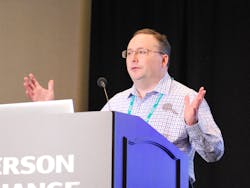Cut the time, slash the paper and boost safety-test reliability
Here’s the challenge: Take an industrial procedure—such as a safety test—that has historically required a thousand pages of reporting, make that procedure more accurate, condense the timing of completing the procedure, gobble up less time from fewer employees and make everybody involved much, much happier.
One solution detailed at Emerson Exchange involved the SIS ProofCheck tool, which claims to ease the process of validating and proving test procedures. The panelists in this presentation validated those claims.
Steven Scherich, senior PTC engineer with Bayer, explained how, at the Kansas City Bayer site where he works, they would perform annual safety checks on 1,160 interlock actions comprised of 696 sensors and 821 actors. The testing produced reams and reams of paper documentation, which teams and teams of interns were tasked with collating into finished reports on sensor/actor data and interlock procedures. Because human beings were involved, training had to take place each year. Human error was expected.
Scherich, joining this Emerson Exchange panel remotely, detailed how his team’s recent adoption of the SIS ProofCheck solution revolutionized his safety-check processes. It eliminated the burden of sifting through redundant documents. Human errors were reduced, and hours were saved by replacing manual data-capture with data aggregated via DeltaV and AMS Device Manager.
The result from early efforts at the facility is a complete electronic record of manual data, device and safety instrument system (SIS)/basic process control system (BPCS) information, not to mention the Bayer workforce dealing with many fewer headaches.
“This is a just better way of doing it,” summarized Maury Bayer, software-development manager and process subject-matter expert with Proconex, an Emerson partner.
As panelists, Bayer and Scherich provided for the audience a quick case study of their joint project. Primary goals were to reduce testing time and make the process repeatable. SIS ProofCheck enabled automatic validation and guided operators and technicians, easily inputting additional data—think standard-operating procedures and pictures that field technicians could rapidly reference while they worked on remote assets. There was no longer a need to climb down the tower to access the help manual.
Reporting was built into the process with SIS ProofCheck, along with the capability to instantly identify failures. The result was a secure, safe, repeatable process. Win. Win. Win.
The new safety-test process produced automated reports highlighting failure responses with notes about the issue and comments on remedy methods. “If you needed to redo a test section, the report shows that you actually found and corrected something, which auditors want to see,” explained Bayer.
While this tool’s greatest attribute, per the presenters, is how it automates formerly manual, laborious processes, Bayer repeatedly stressed the value of complementing the tool with human insights. “With some things you still need the human to verify,” he said. “Is the equipment in the right state? Did a siren go off? With SIS ProofCheck we are collating all of that—from sensors to safety systems, as well as all of those manual activities. We can put all that together in a single document, all wrapped up.”
It is humans, after all, who will benefit from these optimizations. Field technicians can save time spent searching for printed instructions. Engineers can devote their time to higher-level strategic projects. And the interns have more time to make coffee runs.
“We got rid of thousands of pages of paper each year,” said Scherich. “There are savings in man-hours. Our technicians love how it is so much easier. This will pay for itself in one or two years.”
There are better ways to do these things, added Bayer. “And once the templates are in place, it is even easier to roll out to the larger plant,” he said. “This is how you grow from manual processes to the future. This is how you wind up with more maintainable, more secure, more reliable and repeatable processes.”

